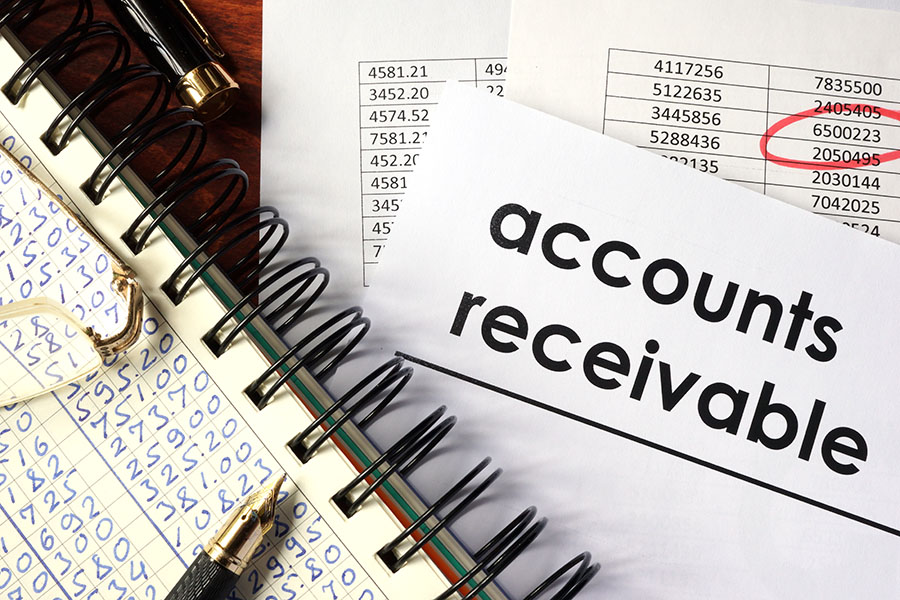We’ll cover how to calculate Accounts Receivable (A/R) Net Realizable Value (NRV) It is the portion of the A/R balance that a company anticipates to receive in cash; this is in contrast to the gross A/R balance, which includes all outstanding invoices, regardless of their likelihood of collection. , which is the estimated amount of cash a company expects to collect from its outstanding customer invoices after accounting for potential bad debts or uncollectible amounts. To get your A/R NRV, calculate the gross A/R and then subtract the Allowance for Doubtful Accounts (ADA) The ADA is a contra-asset account that reduces the value of A/R to its net realizable value. .
A/R NRV is a GAAP requirement that small businesses don’t necessarily have to follow. However, it is a recommended best practice to avoid overestimating the value of your receivables.
Key Takeaways:
- A/R NRV is crucial for reflecting the true value of a company’s receivables and recognizes the reality that not all invoices will be collected in full.
- The ADA is a key component in calculating NRV, representing the estimated uncollected portion of receivables.
- By using NRV, you are presented with a more accurate and conservative picture of your financial health.
Step 1: Determine Gross Accounts Receivable
This is the total amount owed to your company by customers for goods or services sold on credit and is the total amount of your outstanding invoices.
If you need help tracking your invoices, see our guides:
Step 2: Estimate the Allowance for Doubtful Accounts
This is where you assess the portion of your receivables that you might be unable to collect. There are two primary methods for collecting this:
- Aging of receivables method (preferred): Categorize your outstanding receivables based on their age (e.g., 0-30 days, 31-60 days, 61-90 days, over 90 days), then apply different percentages to each category based on the historical likelihood of collection for each aging group. Note that older receivables are generally less likely to be collected.
- Percentage of sales method: Multiply your credit sales for the period by an estimated percentage of uncollectible accounts based on historical experience and current economic conditions. This method focuses on the income statements and bad debt expenses.
Step 3: Calculate the Net Realizable Value
Subtract the ADA from the gross A/R.
Examples of Calculating the Accounts Receivable NRV
Aging of Receivables Method
Let’s say that Illumination Company, a business that sells light fixtures, has a gross A/R of $500,000 at the end of the year. It uses information from its A/R Aging Report to use the aging of receivables method to estimate its allowance for doubtful accounts. Here’s how to calculate the net realizable value of accounts receivable.
Step 1: Calculate the estimated collectible amount for each aging category.
Based on its historical collection experience and current economic conditions, Illumination Company estimates the following uncollectible percentages for different aging categories:
Age of Receivables | Amount | Estimated % Uncollectible | Estimated Uncollectible Amoune |
|---|---|---|---|
0-30 days | $300,000 | 1% | $3,000 |
31-60 days | $150,000 | 3% | $4,500 |
61-90 days | $40,000 | 5% | $2,000 |
Over 90 days | $10,000 | 10% | $1,000 |
Step 2: Calculate the total ADA:
- Total Estimated Uncollectible Amount = $3,000 + $4,500 + $2,000 + $1,000 = $10,500
Step 3: Use the net realizable value of accounts receivable formula to get the NRV:
- NRV = $500,000 (Gross A/R) − $10,500 (ADA) = $489,500
In this example, Illumination Company estimates that it will be able to collect $489,500 of its $500,000 gross A/R. This NRV will be reflected on the balance sheet, providing a more accurate picture of the company’s financial position.
Percentage of Sales Method
Now, let’s use the same example but calculate it using the percentage of sales method. Illumination Company has credit sales of $500,000 for the year. Historically, it’s experienced an average of 2% of credit sales as uncollectible. Its current A/R balance is $100,000.
Step 1: Estimate Bad Debts:
- Bad Debts Expense = Credit Sales × Estimated Percentage of Uncollectible Accounts
- Bad Debts Expense = $500,000 × 2% = $10,000
Step 2: Calculate ADA:
- In this case, we assume there’s no beginning balance in the ADA.
- The Bad Debts Expense of $10,000 will be the ending balance in the ADA.
Step 3: Use the net realizable value of accounts receivable formula to get the NRV:
- NRV = $100,000 (gross A/R) − $10,000 (ADA) = $90,000
The NRV of Illumination Company’s A/R is $90,000. This means that it expects to collect $90,000 out of the $100,000 currently owed to the company. The remaining $10,000 is estimated to be uncollectible and is reflected as an expense (Bad Debts Expense) on the income statement.
Benefits of Calculating the Accounts Receivable NRV
Once you’ve learned how to calculate the net realizable value of accounts receivable, you’ll know it can offer numerous benefits for your business, primarily in the areas of financial reporting and decision-making.
Accurate Financial Reporting
NRV ensures that assets on the balance sheet, specifically A/R, are not overstated. This provides a more realistic and conservative view of a company’s financial position to stakeholders like investors, creditors, and management. By recognizing potential bad debts and adjusting the value of receivables accordingly, NRV promotes transparency in financial reporting.
Informed Decision-making
NRV helps you evaluate the effectiveness of your credit policies. It can also identify areas where collection efforts need improvement. For instance, if the ADA is consistently increasing, it may signal a need to reassess collection strategies.
NRV plays a role in accurate cash flow forecasting as well. By considering potential bad debts, you can develop more realistic projections of your future cash inflows. Understanding NRV helps allocate resources efficiently, because you can prioritize collection efforts on older or riskier accounts, potentially improving overall cash flow.
Factors That Affect the A/R Net Realizable Value
Several factors can affect the NRV of A/R. These factors influence the estimation of the ADA, which directly impacts NRV. This ensures that your financial statements provide a true and fair view of your financial position.
Here are a few of the factors that affect accounts receivable NRV:
- Historical collection experience: A company’s past experience in collecting its receivables is a strong indicator of future collectability. If a company has a history of significant bad debts, it’s likely that its allowance will be higher, thus reducing the NRV.
- Current economic conditions: Economic downturns or recessions can significantly impact your customers’ ability to pay their debts, leading to higher bad debts and a lower NRV. Conversely, a booming economy might lead to lower bad debts and a higher net realizable value.
- Industry-specific factors: Certain industries are inherently riskier than others in terms of collectability. If your company operates in a volatile industry or you serve customers with a history of financial instability, you might need to maintain a higher allowance, impacting NRV.
- Customer creditworthiness: The creditworthiness of your customers is a crucial factor. Customers with poor credit histories or financial difficulties are more likely to default, leading to an increased allowance and lower NRV.
- Credit policies and collection efforts: Your company’s collection efforts and credit policies can influence NRV. Stricter credit policies might result in lower bad debts and higher NRV, while lax collection efforts could lead to the opposite.
- Changes in customer circumstances: Unexpected events like bankruptcies, natural disasters, or major lawsuits can affect a customer’s ability to pay, leading to a potential increase in bad debts and a lower NRV.
- Aging of A/R: The older the receivable, the less likely it is to be collected. Companies will typically analyze the aging of their receivables to estimate the likelihood of collection and adjust the allowance accordingly.
- Disputes or disagreements with customers: Outstanding disputes or disagreements with customers regarding invoices can also affect NRV, as these might lead to delays or non-payment.
Frequently Asked Questions (FAQs)
A/R NRV ensures that assets on the balance sheet aren’t overstated and provides a more realistic view of a company’s financial position. By considering potential bad debts, NRV helps management make better decisions related to credit policies, collection efforts, and financial forecasting. Both GAAP and IFRS require accounts receivable to be reported at their NRV on the balance sheet.
Gross A/R represents the total amount that is owed to a company by its customers for goods or services sold on credit. NRV, on the other hand, is the estimated portion of receivables that the company actually expects to collect, after accounting for potential bad debts or uncollectible amounts.
There are two primary methods for estimating the allowance. The first is the percentage of sales method, in which a percentage of credit sales is estimated to be uncollectible based on historical experience and current economic conditions. The second is the aging of receivables method, in which receivables are categorized based on their age, and different percentages are applied to each category based on the likelihood of collection.
A high NRV indicates that a company expects to collect a significant portion of its receivables, suggesting effective credit policies and collection efforts. A low NRV could imply potential difficulties in collecting receivables, which could impact cash flow and profitability.
Bottom Line
By calculating A/R NRV, you’ll ensure that your business is reporting accurate financials and will also be compliant with accounting standards. If you’re able to master the calculation of NRV, you can gain valuable insights into your credit policies, collection efforts, and overall financial performance. This enables you to make sound financial decisions and thrive in a competitive marketplace.


